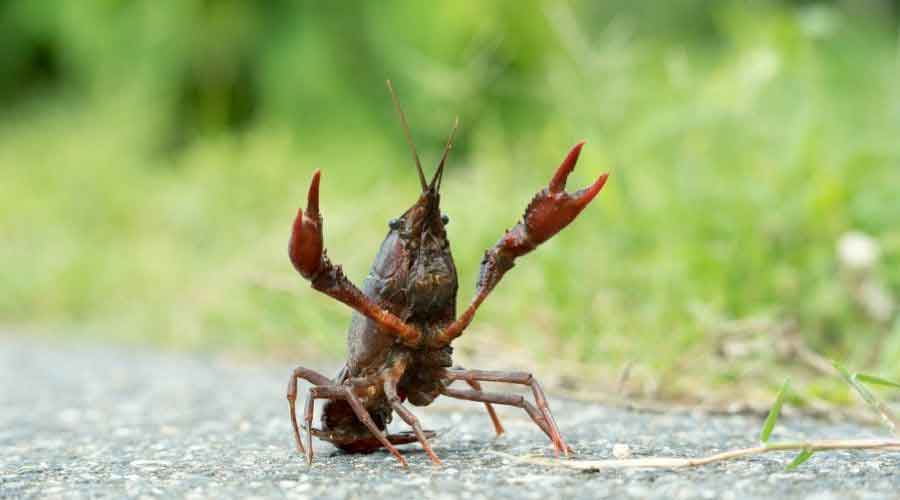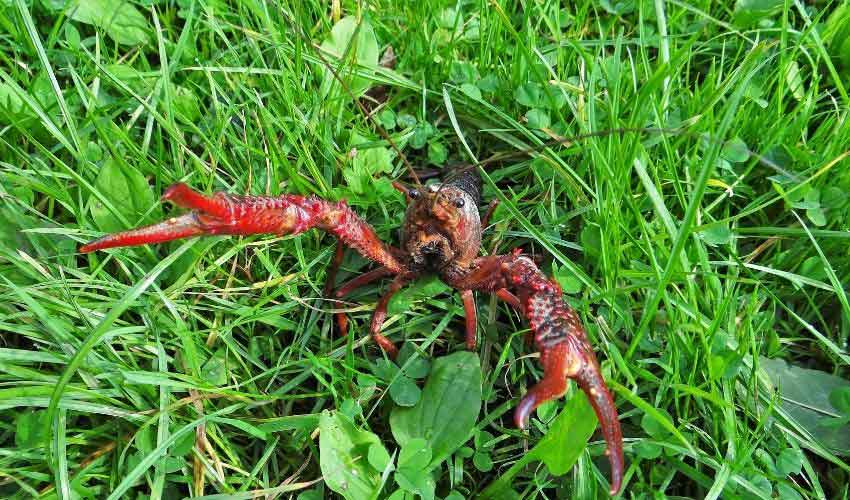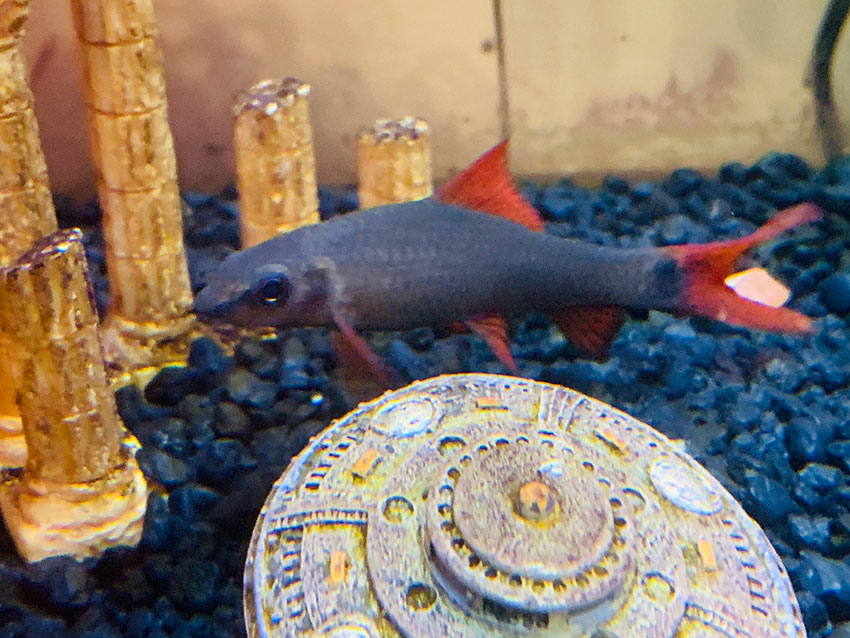In this blog, I’ll discuss red swamp crayfish, also known as the “mudbug,” and the “Louisiana crawfish.” These are the types of crayfish that come to mind when most people think of the word crayfish.
In the article, I’ll go into details about the origin, appearance, behavior, tank requirements, diet, tank mates, molting, and a lot more about red crayfish.
Let’s jump in.
Red Swamp Crayfish: A Guide with Facts, Tips, Pics, and Care Information
Table of contents:
- The origin of red swamp crayfish
- Appearance (color and size)
- Behavior and temperament
- Fish tank requirements for keeping
- Diet and feeding
- Tankmates
- Molting
- Recap
Origin of the Red Swamp Crayfish

If you had to guess, you’d probably guess right on this one. The origin of the red swamp crayfish is the Southeastern part of the United States—a place where Louisiana overwhelmingly dominates the crawfish industry, hands down. The money brought to the state of Louisiana through the crayfish industry yields the state roughly $150 million every single year. That’s a lot of money.
Appearance
The red swamp crayfish, or “red crayfish” as it’s also known, can be found in the colors red, orange, or reddish-brown. However, they can also be bred in certain ways that produce different colors like the popular and highly sought after, “ghost crayfish.” These are beautiful crayfish that are white with different colorations of red and blue. Ghost crayfish can be a bit pricey, too.
Also, red crayfish can grow to be between one and a half to four inches long during their lifespan of two to five years.
The Behavior of the Red Swamp Crayfish
Scientists describe the red swamp crayfish as being nocturnal in nature. However, these crays can also stay pretty busy during the day as well.
They are also diggers, and like a lot of other crayfish, they like to burrow. So, you’ll probably want to get your red swamp crayfish a hideout or two. They will need them.
As far as their temperament goes, the red crayfish or procambarus clarkii, is an extremely aggressive animal. Scientists say because of this, it may actually have helped the red crayfish invade and dominate so many different areas globally, doing irreversible ecological damage. In other words, this crayfish is a bit of a nuisance.
So note, if you decide to keep one of these as a pet, and decide you don’t like it, never just let it go into the wild. Ever! These animals are destructive.

Aquarium Requirements
For my first crayfish, a blue crayfish, I made the mistake of buying a 10-gallon fish tank. It seemed like the right idea at the time, but then I quickly learned why it was not the right thing to do.
It’s simple, crayfish need their space—space to roam and explore, and places to burrow. So, the 10-gallon tank was a bit too small when you consider the fact that I also wanted to keep other fish with my pet crayfish. Also, when you consider the fact that crayfish are extremely dirty animals, 10 gallons just isn’t optimal. So, my next tank for my crayfish was a 20-gallon aquarium.
A 20-gallon fish tank provides enough room to keep a crayfish comfortably. And, it also provides enough room to keep another fish or two. However, it’s critical you select the right types of fish to keep with your crayfish (more on this below).
Diet and Feeding
These guys are crayfish. Which means they are omnivores and will eat almost anything they can get to. In the wild, red swamp crayfish feed on snails, larvae, tadpoles, and live and dead animals. It just doesn’t matter to them. These guys have a very diverse diet and that’s why they can wreak havoc on the ecosystem.
However, when being kept as pets, it’s best to feed red claw crayfish a combination of sinking pellets, brine shrimp, and blood worms. Additionally, they can be fed a day to every two days. Just remember, these guys put out a lot of waste.
Disease
It’s important to point out that the red swamp crayfish can be a host for parasites and nasty diseases. They can also carry crayfish fungus plague. This isn’t exactly the cute little crayfish you buy at the pet store. Also, it’s probably not one you would find and want to add to your normal healthy fish tank.
Tank Mates for Red Swamp Crayfish
Just like most crayfish, red crayfish are very aggressive. They will eat almost anything they can get between their claws. And, this includes the fish in your tank and also other crayfish. So, be sure to keep the right fish in the tank with your crayfish, if you decide to keep this type of crayfish.
Fish that swim fast, might be a little aggressive themselves, and fish that swim in the middle or towards the top of the fish tank work well with crayfish (see neon tetras). However, fish that are slow-moving or swim on the bottom of the fish tank, like snails and plecos, will easily fall prey to the red swamp crayfish.

Below are a few fish that might work with red swamp crayfish.
- Redtail shark
- Rainbow sharks (depending on tank size)
- Tiger barbs
- Tetras
- Danios
- Neon tetras
Even with the careful selection of freshwater fish as tank mates, there is just never a guarantee that your fish will be safe from red swamp crayfish. Crayfish love to eat. With that said, I’ve successfully kept a number of fish in my fish tank with crayfish for years. The key has always been being mindful of tank size and the types of fish I keep with my cray.
Pro tip: I’d recommend not keeping two crayfish in the same tank unless it is a large tank and provides lots of hideouts. Additionally, never keep crayfish of different species together.
Molting
Like I’ve discussed in other blogs, crayfish, who are invertebrates, molt or shed their exoskeletons.
You should be able to tell when this is about to happen because they will become less active—stop eating, go to their hideouts, and just disappear. This is normal behavior during the molting of red swamp crayfish and nothing that should be alarming.
After they molt, they are soft and the most vulnerable to predators. This is another reason why crayfish need their hideouts. So they can hide and burrow while strengthening their new exoskeleton. And to do this, they will often eat their exoskeleton to help them grow stronger. So never remove the exoskeleton from the tank.
Keeping as Pets
It’s important to note, that if you keep the red swamp crayfish as a pet (or any crayfish), please be responsible. Again, don’t ever release them into the wild! As mentioned above, they can do significant ecological damage that is beyond repair. Also, remember the risk of disease with red swamp crayfish. If you randomly add one to your healthy fish tank, you could be asking for trouble.
Recap
Just as a recap, in this blog we took a look at the origin of the red swamp crayfish, their behavior, and their aggressive temperament. The red swamp crayfish is an invasive species and a crayfish known for carrying diseases and doing damage to the ecosystem.
We also took a look at fish tanks that will work the best when keeping red swamp crayfish. And finally, we touched on the diet of red crayfish, appropriate tank mates, and the molting process.
Never release a red crayfish from captivity.
